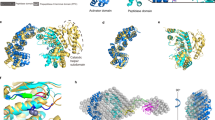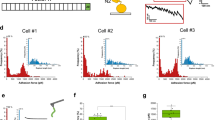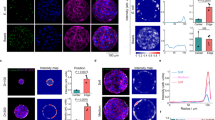Abstract
The crystal structure of the recombinant 19,000 Mr binding domain from the Staphylococcus aureus collagen adhesin has been determined at 2 Å resolution. The domain fold is a jelly-roll, composed of two antiparallel β-sheets and two short α-helices. Triple-helical collagen model probes were used in a systematic docking search to identify the collagen-binding site. A groove on β-sheet I exhibited the best surface complementarity to the collagen probes. This site partially overlaps with the peptide sequence previously shown to be critical for collagen binding. Recombinant proteins containing single amino acid mutations designed to disrupt the surface of the putative binding site exhibited significantly lower affinities for collagen. Here we present a structural perspective for the mode of collagen binding by a bacterial surface protein.
This is a preview of subscription content, access via your institution
Access options
Subscribe to this journal
Receive 12 print issues and online access
$189.00 per year
only $15.75 per issue
Buy this article
- Purchase on Springer Link
- Instant access to full article PDF
Prices may be subject to local taxes which are calculated during checkout
Similar content being viewed by others

References
Hay, E.D., Cell Biology of Extracellular Matrix, 2nd ed. (Plenum Press, New York; 1991).
Rubin, K., Höök, M., Öbrink, B. & Timpl, R. Substrate adhesion of rat hepatocytes: mechanism of attachment to collagen substrates. Cell 24, 463–470 (1981).
Vandenberg, P. et al. Characterization of a type IV collagen major cell binding site with affinity to the α1β1 and the α2β1 integrins. J. Cell Biol. 113, 1475–1483 (1991).
Sasaki, T. et al. Limited cleavage of extracellular matrix protein BM-40 by matrix metalloproteinases increases its affinity for collagens. J. Biol. Chem. 272, 9237–9243 (1997).
Speziale, P. et al. Binding of collagen to Staphylococcus aureus Cowan 1. J. Bacteriol. 167, 77–81 (1986).
Switalski, L.M. et al. A collagen receptor on Staphylococcus aureus strains isolated from patients with septic arthritis mediates adhesion to cartilage. Mol. Microbiol. 7, 99–107 (1993).
Patti, J.M. et al. Molecular characterization and expression of a gene encoding a Staphylococcus aureus collagen adhesin. J. Biol.Chem. 267, 4766–4772 (1992).
Patti, J.M., Boles, J.O. & Höök, M. Identification and biochemical characterization of the ligand binding domain of the collagen adhesin from Staphylococcus aureus. Biochemistry 32, 11428–11435 (1993).
Patti, J.M. et al. Critical residues in the ligand-binding Site of the Staphylococcus aureus collagen-binding adhesin (MSCRAMM). J. Biol. Chem. 270, 12005–12011 (1995).
Laskowski, R.A. et al. PROCHECK: a program to check the stereochemical quality of protein structures. J. Appl. Crystallogr. 26, 283–291 (1993).
Richardson, J.S. The anatomy and taxonomy of protein structure. Advances in Protein Chemistry 34, 167–339 (1981).
Connolly, M.L. The molecular surface package. J. Mol. Graphics 11, 139–141 (1993).
Bella, J. et al. Crystal and molecular structure of a collagen-like peptide at 1.9 Å Resolution. Science 266, 75–81 (1994).
Sakakibara, S. et al. Synthesis of (Pro-Hyp-Gly)n of defined molecular weights. Evidence for the stabilization of collagen triple helix by hydroxypyroline. Biochim. Biophys. Acta 303, 198–202 (1973).
Heidemann, E. & Roth, W. Synthesis and investigation of collagen model peptides. Adv. Polym. Sci. 43, 143–203 (1982).
Segal, D.M. & Traub, W. Polymers of tripeptides as collagen models. VI. synthesis and structural investigation of poly(L-alanyl-L-prolyl-glycine). J. Mol. Biol. 43, 487–496 (1969).
Brünger, A.T. X-PLOR manual, version 3.1 (Yale Univ. Press, New Haven, Connecticut, USA; 1992).
House-Pompeo, K., Boles, J.O. & Höök, M. Characterization of bacterial adhesin interactions with extracellular matrix components utilizing biosensor technology. METHODS: A Companion to Meth. Enz. 6, 134–142 (1994).
Nemethy, G. et al. Energy parameters in polypeptides. 10. improved geometrical parameters and nonbonded interactions for use in the ECEPP/3 algorithm, with application to proline-containing peptides. J. Phys. Chem. 96, 6472–6484 (1992).
Chen, J.M. et al. An energetic evaluation of a “Smith” collagen microfibril model. J. Protein Chem. 10, 535–542 (1991).
Jiang, F. & Kirn, S.-H. “Soft Docking”: matching of molecular surface cubes. J. Mol. Biol. 219, 79–102 (1991).
Ho, S.N. et al. Site-directed mutagenesis by overlap extension using the polymerase chain reaction. Gene 77, 51–59 (1989).
Author information
Authors and Affiliations
Rights and permissions
About this article
Cite this article
Symersky, J., Patti, J., Carson, M. et al. Structure of the collagen-binding domain from a Staphylococcus aureus adhesin. Nat Struct Mol Biol 4, 833–838 (1997). https://doi.org/10.1038/nsb1097-833
Received:
Accepted:
Published:
Issue Date:
DOI: https://doi.org/10.1038/nsb1097-833
This article is cited by
-
Evaluation of the biofilm formation of Staphylococcus aureus and Pseudomonas aeruginosa on human umbilical cord CD146+ stem cells and stem cell-based decellularized matrix
Cell and Tissue Banking (2020)
-
Bent conformation of a backbone pilin N-terminal domain supports a three-stage pilus assembly mechanism
Communications Biology (2018)
-
Surface proteins involved in the adhesion of Streptococcus salivarius to human intestinal epithelial cells
Applied Microbiology and Biotechnology (2018)
-
Isopeptide bond in collagen- and fibrinogen-binding MSCRAMMs
Biophysical Reviews (2016)
-
Inactivation of sortase A mediated by metal ATCUN complexes
JBIC Journal of Biological Inorganic Chemistry (2014)


